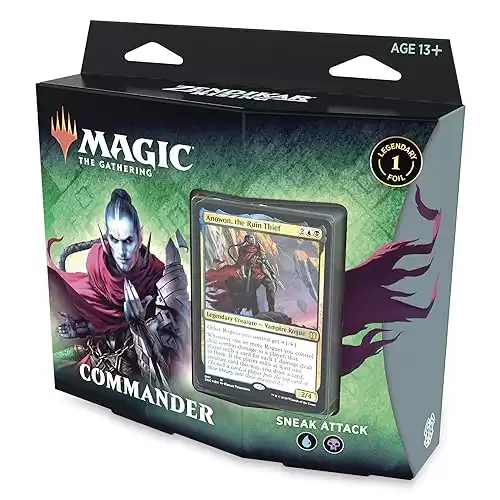Mill is a competitive keyword that has been introduced very recently into magic, but the effect has been around since Antiquities.
Mill is a keyword action targeting a player or players. For a player to mill a number of cards, that player puts that number of cards from the top of their library into their graveyard.
While this seems simple there are a lot of interactions that can get tricky, and deadly. If you want to know how to use Mill, how to play against Mill, or anything in between, then this is the guide for you.
What is Mill?
“To mill a number of cards, a player puts that many cards from the top of their library into their graveyard. “
Magic: The Gathering Comprehensive Rules
Mill is an ability that allows you to remove cards from a player’s deck and put them in their graveyard. Creatures, sorceries, instants, enchantments, and artifacts used the keyword from as recently as Core Set 2021. This wide variety of spell types gives you a lot of deck-building options.
What Are The Rules For Mill?
Whenever a card says for target player to Mill a number of cards, target player puts that many cards from the top of their library into their graveyard.
Let’s say that you have a Necrotic Ooze on the battlefield, and you cast Fractured Sanity with two opponents.
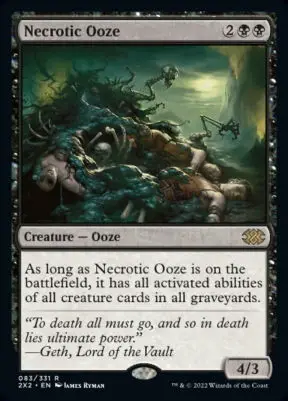
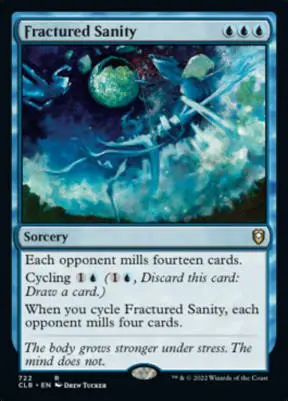
Your opponents would each put the top fourteen cards of their libraries into their graveyards at the same time. If any creatures with activated abilities would be put into the graveyard, Necrotic Ooze gains those abilities after Fractured Sanity resolves.
What Is The History Of Mill?
Millstone was the first card with the mill mechanic.
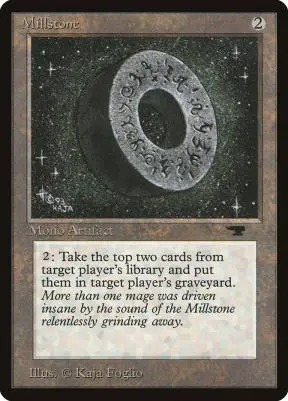
The Core Set 2021 was the tournament legal set with the keyword mill. The keyword was named mill because it was used amateurly. Before the mechanic became a keyword, by players unofficially which made naming the keyword easy. The name was also an homage to millstone.
The term “mill” was used long before the keyword was introduced. As more cards with the mechanic were printed, the more it was played. The Innistrad block saw a substantially increased amount of mill played. This increased amount of play lead to it being named as a keyword.
How Does A Mill Deck Win?
In Magic the Gathering, when you attempt to draw a card from an empty library, you lose the game. To “deck” is to lose the game in this way. The goal of a Mill deck should be to win by decking your opponent, by taking advantage of large graveyards, or by milling yourself and using those cards.
Optimally, a great Mill Deck will have a healthy balance of the three. Combos work great and can be implemented naturally, it just depends on how competitive you want to play.
Related Article: MTG Infinite Combos – An Ultimate Guide
How Do You Play Against A Mill Deck?
Playing a mill deck can feel like an exciting race against the clock, with your opponents racing to win before they run out of cards to win with. In other words, an aggressive deck and aggressive play style counter mill decks. In addition, cards such as Relic of Progenitus, Bojuka Bog, and Fraying Sanity that remove graveyards can shut down a setup player.
How Do You Build A Mill Deck?
A good mill deck will feel like assembling a puzzle. Above all, if you happen to choose to have infinite combos in your deck as a win condition. It is because of this that you should run tutors in your deck. Similarly, mill decks should incorporate a lot of cards to sift through your deck. Some examples include Preordain or Sensei’s Divining Top.
Dimir, the name for a deck using Blue and Black, is a staple of mill. Dimir is good for this because blue has a lot of cards with mill, and black has a lot of cards that work off of large graveyards. Dimir also has multicolored cards that work well suc as Consuming Aberration
Mill decks should generally not focus on just one of the aspects of mill, but should instead work to incorporate the best part of all of them. For instance, use cards such as Necrotic Ooze for taking advantage of large graveyards. Secondly, combos that give infinite lands work well with cards such as Mind Grind to kill your opponents in one turn.
Related article: MTG Deck Building Guide – How To Win More Games
Is Mill An Effective Strategy In EDH?
Yes! There are many great commander cards that make mill a viable option in EDH.
The commander options available make up for the increased library size of 100 that you will need to break through. The commander options allow you to get a head start and keep up with your opponents.
Does Milling Count As Discarding?
Milling does not count as discarding. Any effects that trigger from one, do not trigger from the other.
How Does Mill Work With Leyline Of The Void?
With Leyline of the Void in play, you can still use mill effects. The only difference is that the cards never go into the graveyard, and instead go right into exile.
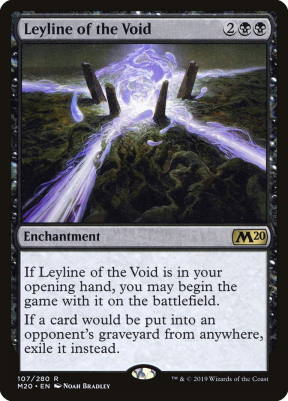
What Happens If I Don’t Have Enough Cards To Mill?
“A player can’t mill a number of cards greater than the number of cards in their library. If given the choice to do so, they can’t choose to take that action. If instructed to do so, they mill as many as possible”
Magic: The Gathering Comprehensive Rules
You do not lose the game when your library has no cards left, you lose the game when you attempt to draw from an empty library.
Best Mill Cards
With such a wide variety of card types with mill, each type of spell deserves its own top 5 list. It just wouldn’t do Mill justice to narrow it down to just five cards.
Creatures
While playing mill, creatures are your fortress. That is so say that they need to keep you alive long enough to get the pieces you need.
On the other hand, creatures can be some of your best assets, and can often make your ‘pieces’ a lot more effective.
5. Undead Butler
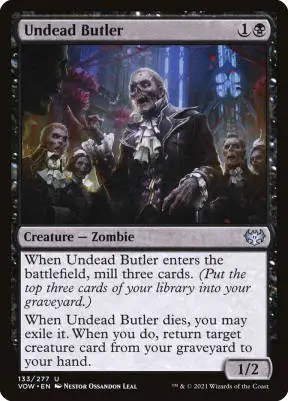
Undead Butler is an example of a card that would work well in self-mill decks. For example, you can use Undead Butler to block with no care whether or not it dies. Then, as long as your deck has been built with self-mill in mind, you can get a creature with good value that you may have milled.
One of the great aspects of this card is it’s converted mana cost. A lot of cards that work with self-mill have high converted mana costs. Undead Butler is a defensive tool and a graveyard tutor all for just two mana.
| Pros | Cons |
| Low converted mana cost | Does not have a lot of value in decks without self mill |
| Great for blocking | Not valuable alive |
4. Hedron Crab & Ruin Crab
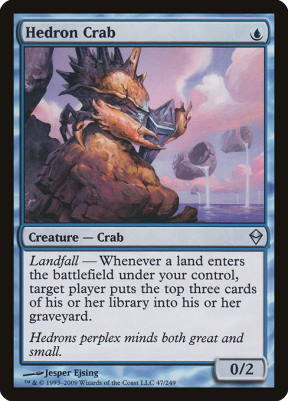
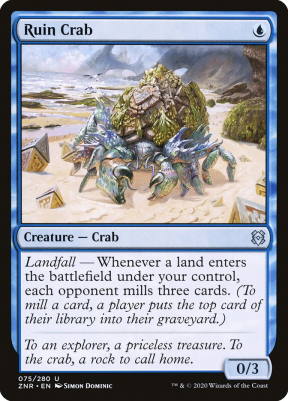
Functionally, Hedron Crab and Ruin Crab are the same card. The crabs are solid creatures for an mill deck. Not only can you run them both, but either are a great card to run in any mill deck. For each of these crabs in play, and for each opponent, and for each land played, three cards are added to graveyards. Consequently, the numbers can add up very quickly. The great potential for value is why these little guys earn a spot on this list.
| Pros | Cons |
| Great possibility for high mill | Works best with multiple opponents |
| Costs one blue mana | Needs consistent land drops for best value |
3. Riddlekeeper
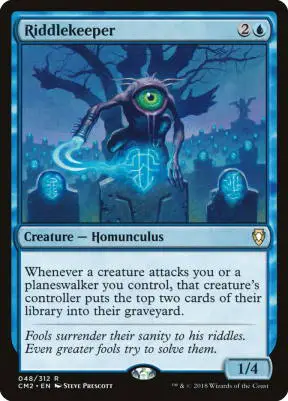
Riddlekeeper acts as a defensive by making your opponent mill cards if they want to attack you. A lot of cards with great value come at the cost of stats, making blocking and defense a challenge. This card negates that challenge of being swarmed and can make your opponents mill some more cards while they try to beat you down.
| Pros | Cons |
| Keeps opponents from swarming | Does not deter large creatures |
| Milled cards can add up quickly | Susceptible to creature removal |
2. Consuming Aberration
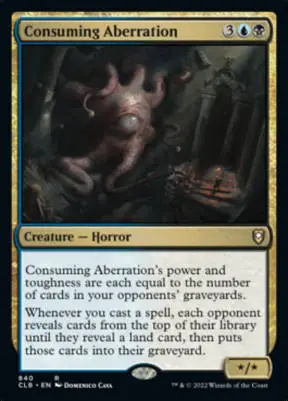
Consuming Aberration earns its number two spot because of its ability to mill and work off of graveyard size. If Consuming Aberration just had the ability to equal the number of cards in each opponent’s graveyards it would still be a very valuable card. The fact that it also has the ability to mill potentially large amounts of cards from your opponent makes it incredible. If your deck focus on the size of your opponent’s deck, Consuming Aberration shows that size really does matter.
| Pros | Cons |
| Can find great value in the mid to late game | Susceptible to creature and graveyard removal |
| Works well in longer formats such as EDH | Works best with more than one opponent |
1. Bruvac the Grandiloquent
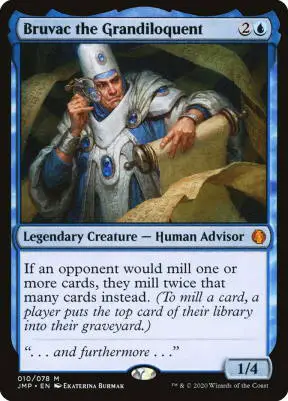
Bruvac the Grandiloquent is a great creature to run in mill. For a converted mana cost of just three, the value is endless. Bruvac can be a piece of one-turn kills, a replacement for combo pieces, or just a plain great card. When he isn’t your commander, Bruvac should be in your deck.
| Pros | Cons |
| Low converted mana cost for value | Susceptible to creature-kill spells |
| Can easily defeat opponents | Huge target in play |
Honorable mention: Necrotic Ooze

Necrotic Ooze is a fantastic card for all different types of decks. However, because it simply reacts to mill instead of adding to it I did not feel that it should be in a list of top mill creatures. Don’t get me wrong, Necrotic Ooze should definitely go into your deck and it will perform well, it is still a great card for mill decks.
Instants and Sorceries
Instants and sorceries are where the *oomph* of mill decks comes from, with help from creatures and enchantments, they can deliver the finishing blow to your opponents.
The trick is getting those spells at the right times, and getting as much value as possible out of them.
5. Brain Freeze
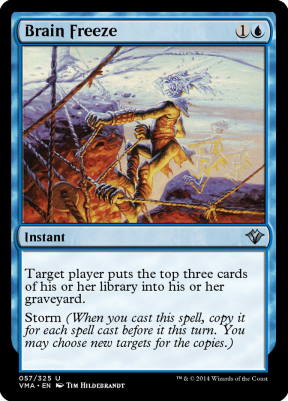
Brain freeze is another card with very high potential. For example, if you have a lot of cantrips to draw cards for little mana this card is fantastic. If you just have a few draw spells here and there, you won’t find as much value as you may like. If you manage to cast three additional spells, you break even with spells of similar mana cost. Anything more than that and you’ve gained overall value.
| Pros | Cons |
| High potential for value | Very hard to save enough sifting cards to get great value |
| Rewards sifting cards | Only one opponent is affected |
4. Drown in the Loch
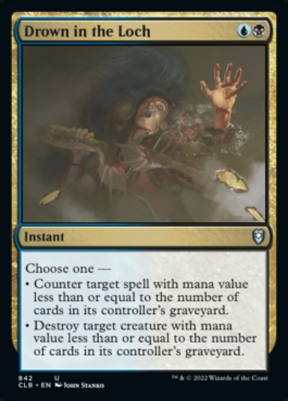
Drown in the Loch is a perfect fit for any mill deck. As long as you don’t plan on playing this on turn two, the card is a counterspell or a removal all in one for just two mana. In a mill deck, it is very easy to reach even 10 cards in a graveyard quickly. For instance, cards like Glimpse the Unthinkable can hit that in two mana. If you are putting any thought into the size of your opponent’s deck, this card will fit right in.
| Pros | Cons |
| Great alternative card made for mill decks | Needs a bit of setup |
| Card has two great options to choose from | Two colors |
3. Archive Trap
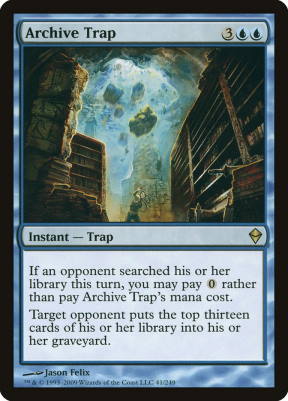
Archive Trap is an amazing card because of its easy trigger. Players search through their library very often in every format of Magic. Not only is this card great to get early game because players, optimally, are searching their library for lands, but you can get that early trigger to start your milling off strong. It’s also great for the amount of cards that it mills. Glimpse the Unthinkable is a great tool being two mana for 10 milled cards, Archive Trap can be 13 cards for zero mana.
| Pros | Cons |
| Most likely going to get great value | Can take a while to trigger depending on your opponent(s) |
| Can be good at most points in a game | Limited options – you either play it when your opponents search or you wait for the next time |
2. Visions of Beyond
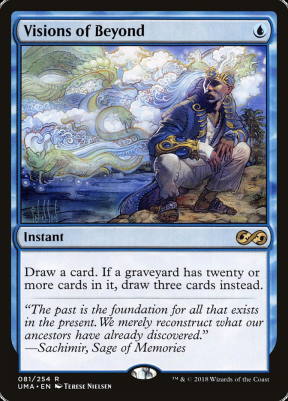
Visions of Beyond solves a problem that mill can run into; card draw. Of course, blue has a lot of card draw options from cards like Blue Sun’s Zenith or Pull from Tomorrow, however neither have the value of Visions of Beyond. Visions of Beyond is great in both self-mill and traditional mill decks. Above all, really has the power to be the boost you need to win a slow, or medium-paced game.
| Pros | Cons |
| Great value | Requires some setup |
| Instant speed – can save the open mana until opponents end step | Susceptible to graveyard removal |
1. Cut Your Losses / Traumatize / Maddening Cacophony
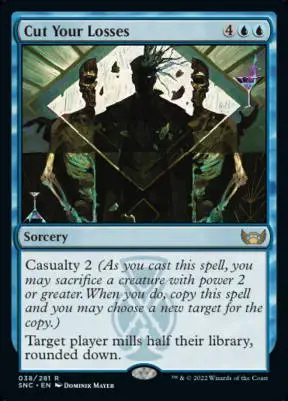
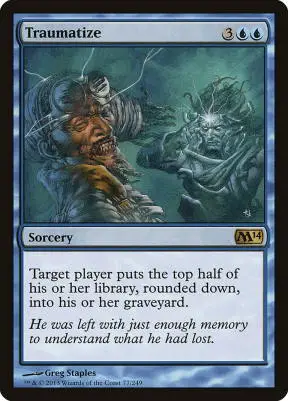
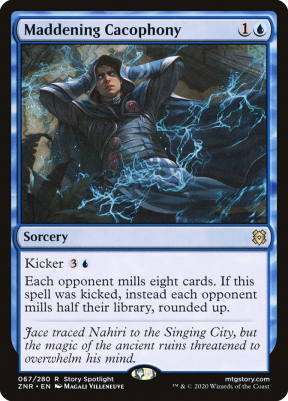
These are your win cons. They are the cards to kill your opponent(s) or just get rid of a ton of their cards which will reduce their chances of winning. Any one of these cards played with Bruvac the Grandiloquent on the battlefield will mill either your opponents entire deck, or all but two cards of it. For this reason, these cards have easily won me over for being the best spells in the instant and sorceries list.
| Pros | Cons |
| One turn kill potential | Needs Bruvac the Grandiloquence for best value |
| Works off of cards that need cards in graveyards | High converted mana cost |
| Even when you don’t get the one turn kill, still great value |
Enchantments
The backbone of your deck, enchantments create value for all of your pieces.
They can be used for milling, making your mill more effective, or placing stress on your opponents. The problem is using the right ones, and the ones that fit the best in your deck.
5. Drowned Secrets
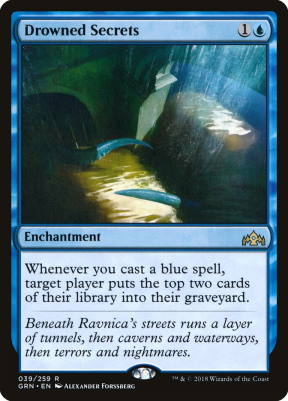
In a mill deck, most of the cards are blue even if you’re playing Dimir. Because of this, Drowned Secrets will optimally trigger multiple times every turn. Passive mill enchantments like this can add up every quickly and make great additions to your deck. Another great thing about Drowned Secrets is that you can target yourself.
| Pro | Cons |
| Passive Mill | Not as efficient in Dimir decks |
| Can target yourself | Can take a few turns to break even on value |
4. Psychic Corrosion
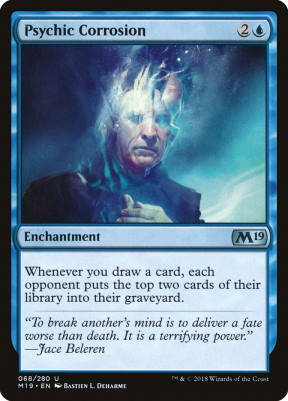
Psychic Corrosion works best when there are multiple opponents. When you start playing cards like Blue Sun’s Zenith, Pull from Tomorrow. and Visions of Beyond the numbers can add up very quickly. Passively milling every opponent by two cards every turn can already be effective. However, when you mix Psychic Corrosion with cantrips (cards that let you draw for cheap), you can shred your opponent’s deck just by looking for better cards.
| Pros | Cons |
| Hits all opponents | Best with multiple opponents |
| Can reach very high numbers very quickly | Slightly higher converted mana cost than Drowned Secrets |
3. Fraying Sanity
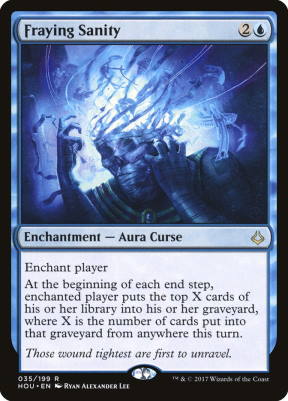
Fraying Sanity is great for a single target mill enchantment. This card effectively doubles any mill done to the target opponent. It is incredibly easy to kill an opponent when they are getting rid of cards twice as fast. This is great with multiple opponents as well because the cards milled from spells that target all opponents are still doubled for the cursed player.
| Pros | Cons |
| Another way to double mill | Only one target |
| Works well off of any other mill card | The targeted opponent will more than likely treat each turn like a final stand against you, or at least target you heavily |
2. Mirrormade
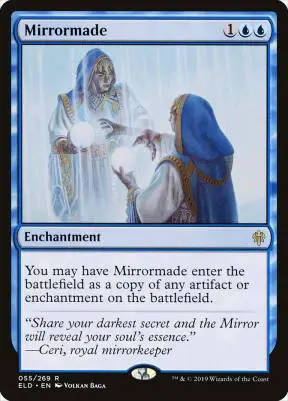
Imagine any of the past enchantments, doubled. That is exactly what Mirrormade[/c[ does. [c]Mirrormade is yet another way to double an aspect of your mill. If this was used on Fraying Sanity on the same player then they get rid of triple the amount of cards. If Mirrormade was cast as Psychic Corrosion then every time you draw a card, every opponent mills 4 cards. There are many possibilities with Mirrormade that make defeating opponents very easy.
| Pros | Cons |
| Allows for flexibility and creativity | Requires a good enchantment to be on the battlefield |
| Can just be a really fun and powerful card to use | Can be too slow to really see the card’s full potential |
1. Court of Cunning
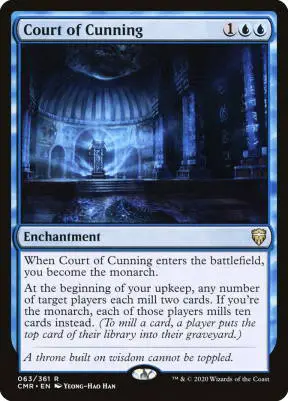
Court of Cunning is a very powerful card for passive mill. It can be good with multiple opponents because Court of Cunning affects all of them. It can be powerful with one opponent because it is easier to stay the monarch. Imagine Court of Cunning with Mirrormade. If you are ever the monarch that’s a passive 20 milled cards for each opponent. That along with Bruvac the Grandiloquent and the numbers get crazy.
| Pros | Cons |
| Great possibility for high | Need to stay the monarch for the best value |
Commanders
As I’ve said before, there are many different ways to build a mill deck. No card will change what your deck focus’ on more than your commander.
Here are some of my favorite commanders for mill, one of which will be familiar.
3. The Mimeoplasm
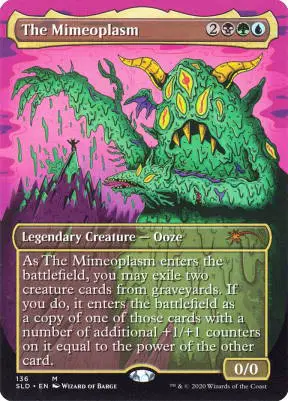
I haven’t touched on green at all in this article, but The Mimeoplasm can be a competitive powerhouse. The way you build The Mimeoplasm is to focus on self-mill, and run cards such as death’s shadow for stats and necrotic ooze for abilities. There are many different ways to play The Mimeoplasm, but almost all of them will get very good very quickly.
2. Phenax, God of Deception
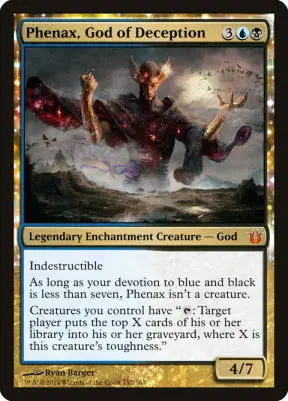
Phenax, God of Deception is definitively one of the best mill commanders. His ability for you to mill passively and put use to cards such as Riddlekeeper that really only existed to be defensive make him a value printer. A huge pro to Phenax, God of Deception is that you are able to run Dimir and keep your deck relatively simple. To clarify, simple meaning cards similar to those found in this guide.
1. Bruvac the Grandiloquent

Wow! It’s Bruvac again. The ability to always be able to double a mill spell is too powerful for me to not put him in the number one commander spot. The problem with running Bruvac the Grandiloquent as your commander is that you have to play mono blue, so you do miss out on a lot of power the other colors, like black would provide. This is made up for by the large amount of mill and card draw that blue has at its disposal.
End Step
If you were to take anything away from this guide, I hope it’d be the power that a mill deck can have. Whether this helps you play with mill better, build a new deck, or defeat that one friend with the perfect one, I hope this guide has benefitted you in some way.
If you don’t think that mill is the deck for you, be sure to check out some of the other guides on Blue Monkey Gaming. Have a good one!

